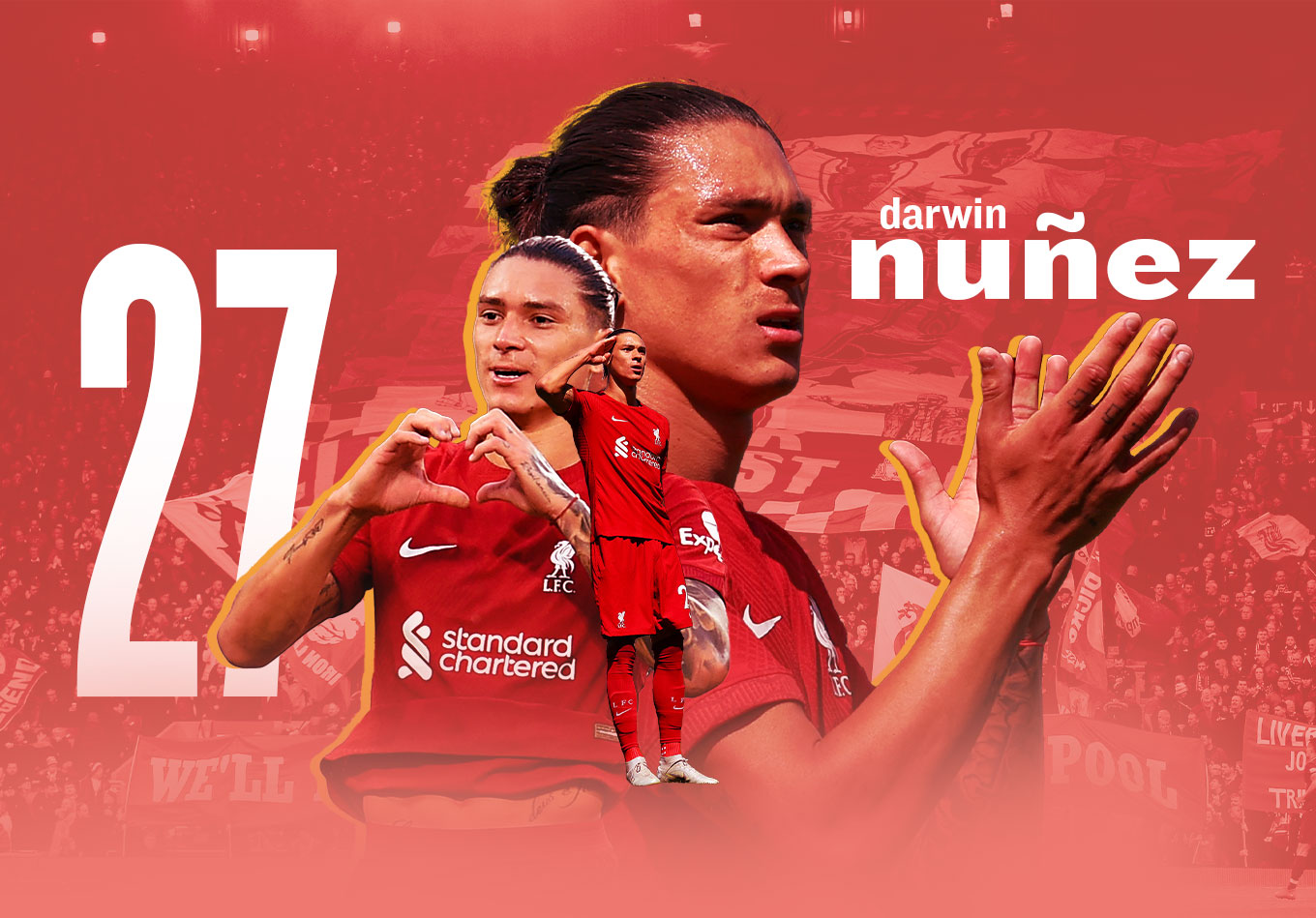He’s not even started 10 games yet in his Liverpool career. But already Darwin Núñez has been branded the agent of chaos.
Ever since his arrival in the summer, the Uruguayan has been under intense scrutiny. A potential club record transfer fee was amplified by the fact that he joined Liverpool just as Erling Haaland moved to Manchester City, two big money strikers moving to the best two sides in England over the last few years. The result is that the microscope has been firmly trained on Núñez.
Haaland’s blistering start to life in the Premier League hasn’t helped either. It has led some rival fans to mock the apparent lesser impact of Núñez.
But make no mistake, the former Benfica man has made an impact. A chaotic, frantic, hectic impact. Some would say it’s almost impossible to predict what will happen when Núñez has the ball. And in a way that’s true.
Except it also isn’t. Because if there’s one thing we can say about the 23-year-old from his Premier League career so far, even if it is from barely over 500 minutes of action, it’s that he guarantees chance generation for Liverpool.

Breaking Down the Chaos
Let’s show you what the stats say. Below is a graph of the Premier League players with at least 500 minutes under their belt this season who, per 90 minutes, have been involved in the most open-play sequences that end in a shot for their team.
And look who tops the lot.
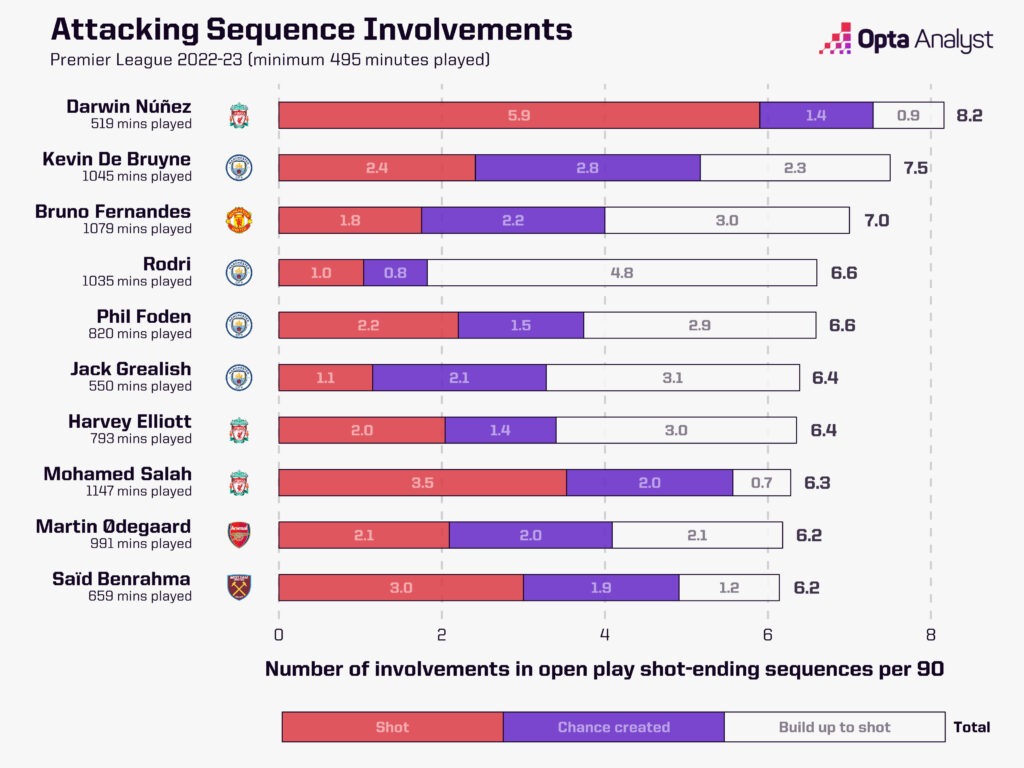
Núñez is above the likes of Kevin De Bruyne and Bruno Fernandes. Above even his Liverpool team-mate, one of the club’s greatest ever, in Mohamed Salah.
From open play, Núñez has either attempted (5.9), created (1.4), or been involved in the build-up (0.9) to 8.2 open-play shots every 90 minutes he has played on average in the Premier League.
For context, that’s more open-play shots than five entire teams are averaging per game in the Premier League in 2022-23 (Bournemouth, Brentford, Everton, Nottingham Forest and Crystal Palace, for those wondering).
You’ll notice in the graphic above that Núñez’s section of the chart is dominated by a rather large chunk of red – or in other words, his attempted shots.
If we include set plays, the Liverpool forward is firing in 6.2 shots per 90 minutes of play in the Premier League.
Since Opta have full shot data in the competition (from 2003-04), that average is the highest by any player in a single season on record (500+ mins), beating Wayne Rooney’s 26-goal 2009-10 campaign.
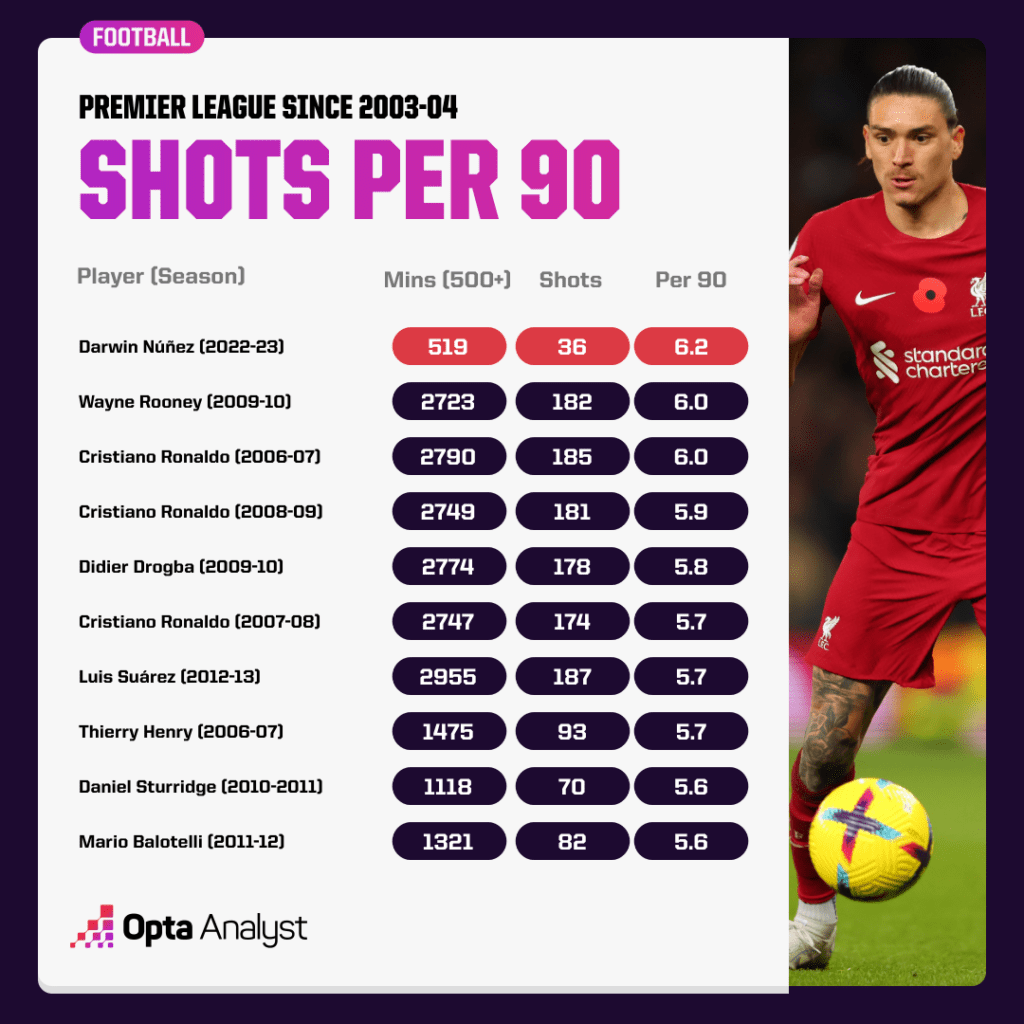
While his game time has been limited compared to others in the table, Núñez is also above players like Cristiano Ronaldo, Didier Drogba, and even above his compatriot Luis Suárez.
If there’s one thing we can take from the players in the list above, it’s that having such a high volume of shots is an indicator of a strong goalscorer. It’s not rocket science. Players that get themselves into shooting positions the most are more likely to score goals. Indeed, over the 19 Premier League seasons from 2003-04 to 2021-22, the player who attempted the most shots in each season also ended up as the top scorer that campaign nine times, was in the top three scorers 14 times, and was in the top five scorers 18 times. Put simply, if you want to score lots of goals, you probably need to have lots of shots. Núñez is doing that, and then some, right now.
And the reason Núñez is able to attempt as many shots as he has is because of how direct he is. His first thought is how to get himself, and indeed his team, into a dangerous area. 27% of his touches in the Premier League this season have been in the opposition’s box – only Haaland (32%) can beat that ratio in 2022-23 of players who have had 200+ touches.
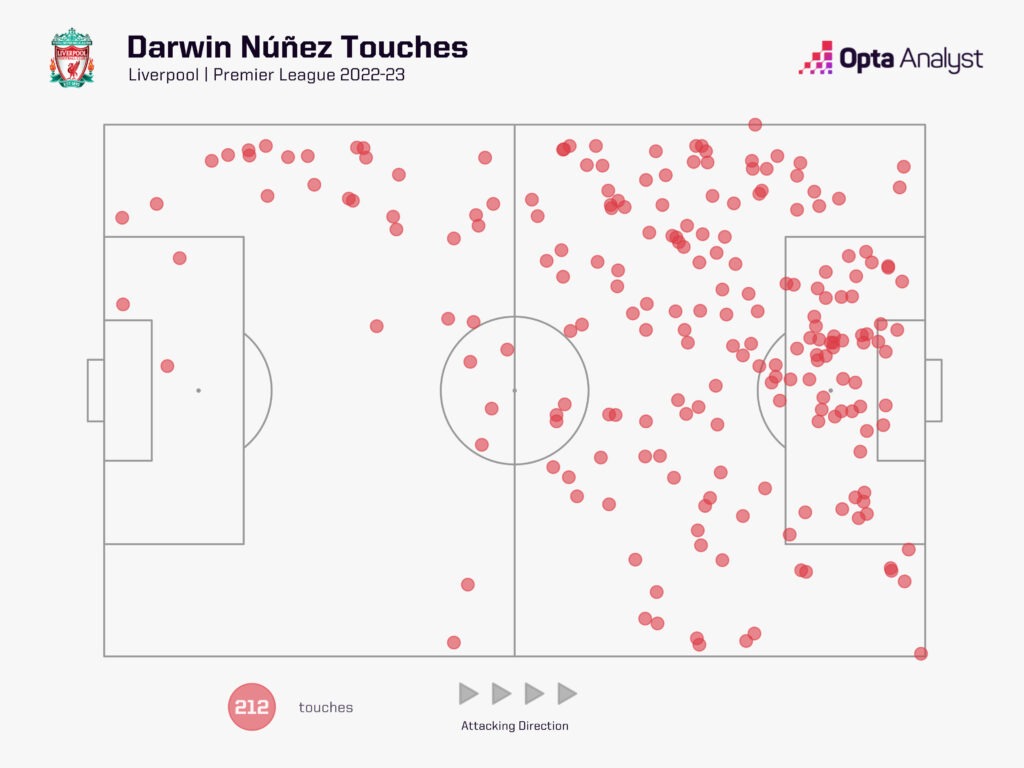
So Núñez is shooting often and getting into the box regularly. Combine the two, and it’s no surprise that his per 90 figures for expected goals (excluding penalties, since Núñez is yet to take one for Liverpool) rank second in the Premier League, behind only the current runaway leading scorer, Haaland.
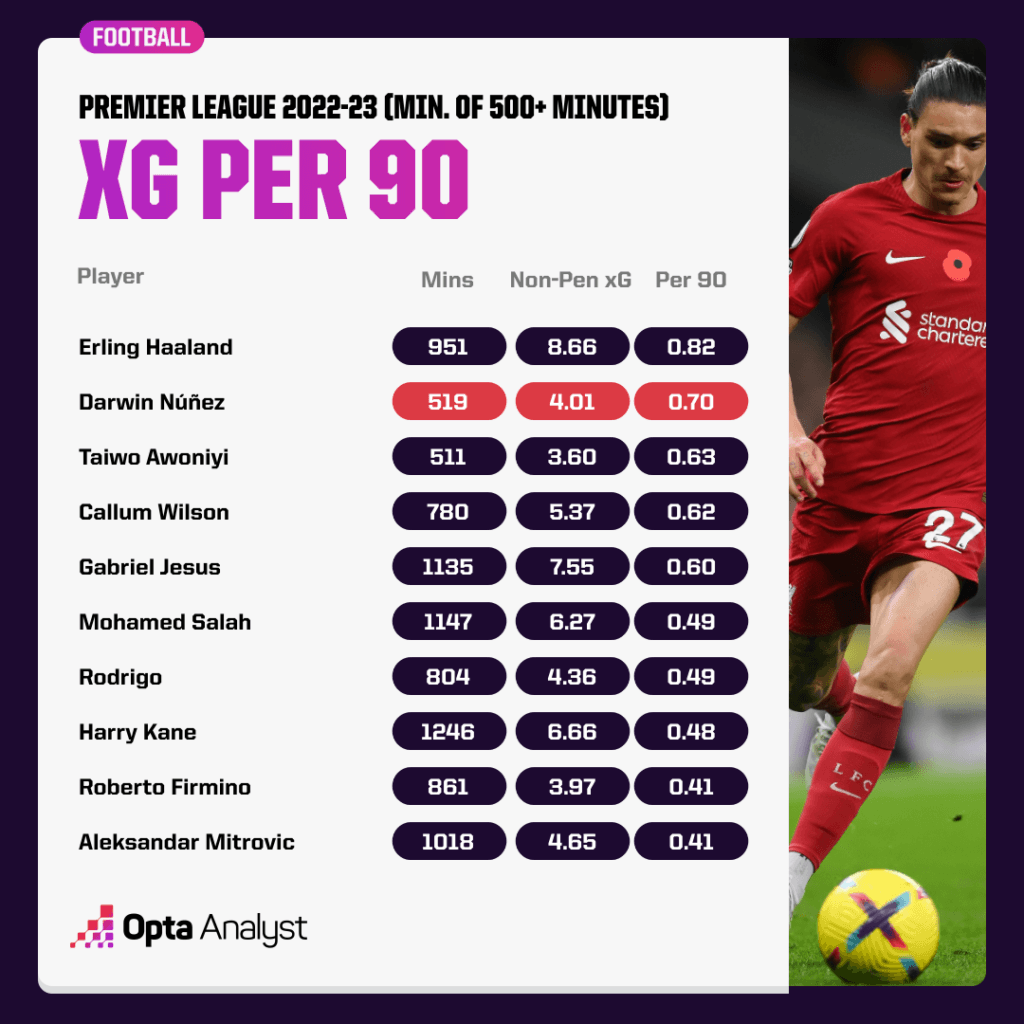
It’s not a fluke that Núñez is getting himself into threatening positions and shooting so often. It’s a skill in itself, the art of a goalscoring centre-forward. He is a nightmare for defenders.
But can he keep it up?
Remember, even though he’s only 23, Liverpool signed Núñez off the back of him scoring 71 goals in his last three seasons at club level, including 34 for Benfica last term.
As the Uruguayan has played little over 500 minutes in his Premier League career so far, it’s worth comparing his figures to his Primeira Liga data last season, where he scored 26 goals in 28 appearances.
In the league last term, Núñez averaged 3.9 shots per 90 – considerably lower than his 6.2 average in the Premier League. His non-penalty xG per 90 was more similar though, at 0.69 compared to 0.70 in England. This is because the quality of the chances he was taking were better, with his non-penalty xG per shot averaging at 0.19 – that’s down to 0.11 for Liverpool.
But where he has improved for the Reds is just how often he’s getting into the box, with 27% of his Premier League touches coming in the opponent’s penalty area compared to 24% in last season’s Primeira Liga.
A word many use to describe Núñez is raw, and there is certainly room for refinement in his game. Can he blend the quantity of shots he’s having at Liverpool with the quality of chances he was having at Benfica?
While he may be only nine games into his Premier League career, there are signs that Liverpool’s new centre-forward is already refining his game. Below is a comparison of Núñez’s first five Premier League appearances against his most recent four – where he’s played a similar number of minutes across both periods:
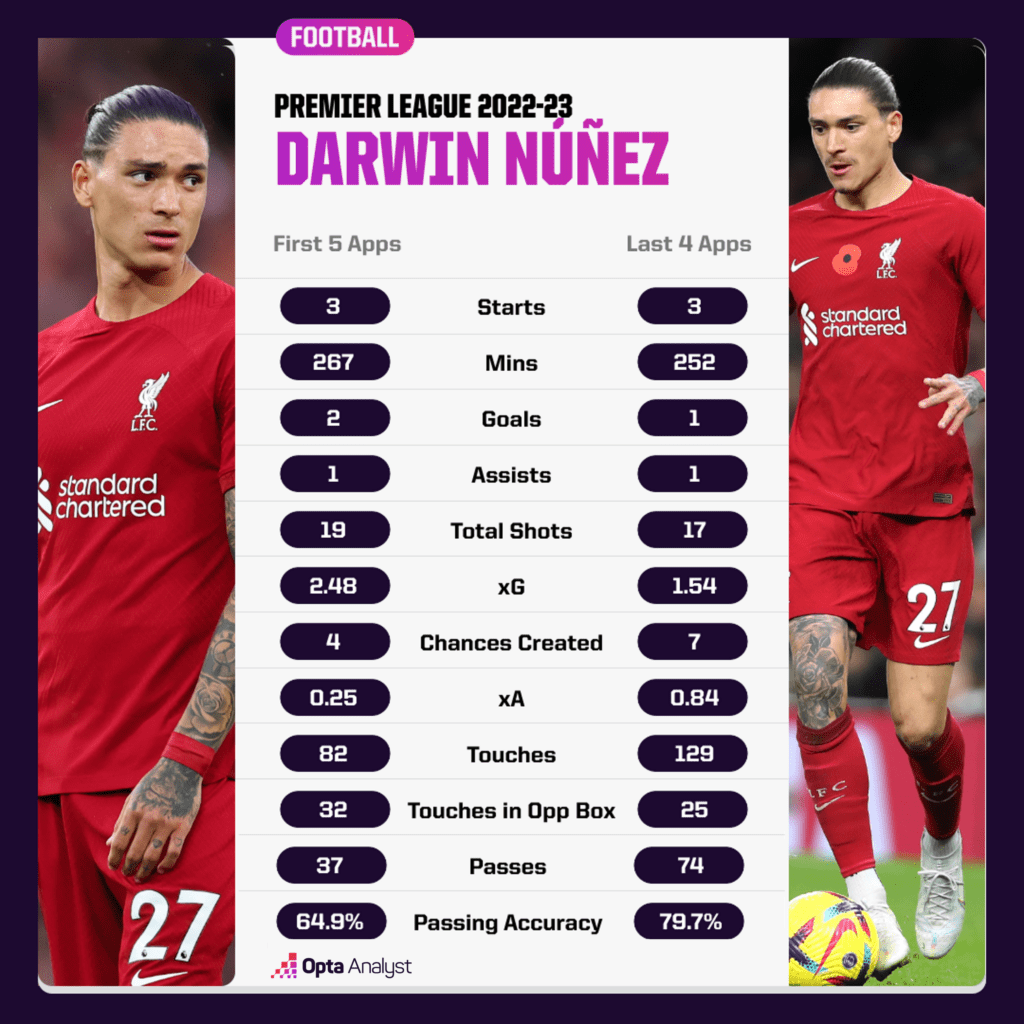
There is one caveat in the above data to note. Of his most recent four games, he started the last of those against Tottenham on the left flank, rather than his usual central striking role.
That said, his shot output has stayed relatively similar, but his overall play is showing improvement. He’s creating more chances, his expected assists have shot up, he is more involved in games and his overall passing accuracy is much higher. His assist for Salah’s opener against Tottenham was a great example of how his all-round game is already improving under Jürgen Klopp. A quality first touch coupled with a composed pass inside the area for Salah to finish.
Overall, Núñez has seven goals and two assists in his first 17 appearances for Liverpool. Only five players – Robbie Fowler, Fernando Torres, Daniel Sturridge, Mo Salah and Diogo Jota – have managed more goals in their first 17 games for the Reds in the Premier League era.
But Núñez has only started nine of his 17 games. His mins/goal rate is 122. That’s a better average than any Liverpool player with 10+ appearances for the club post-war. For context, the best such rates by post-war Liverpool players are from John Aldridge (130), Salah (132), Torres (135), and Suárez (138). Núñez can’t do much more from his fledgling Liverpool career so far than better the rates of players of that calibre at the club.
He may be unpredictable. He may be raw. He may be chaotic. But Liverpool fans should embrace the chaos that is Darwin Núñez.

How Liverpool Embraced the Chaos
All of the talk in the summer was centred around how the addition of Núñez would see Liverpool evolve as a team. After all, for the first time under Jürgen Klopp, the Reds had a proper centre-forward within their ranks.
There have been changes in structure and shape but Núñez himself has evolved his game since the move to Merseyside. It needed to be a case of give and take if this was to be a success. The Reds couldn’t change everything to accommodate their £65 million summer signing as it would almost certainly have a negative impact on others.
We witnessed it first-hand earlier in the season when Liverpool used Salah as a creative wide player. It had some benefits but nowhere near enough to justify the decision to turn one of the most potent attackers in Premier League history into more of a winger.
With Salah and Luis Díaz occupying wider areas, it opened up a more direct route to Núñez. In his earlier outings for Liverpool, the full-backs were the ones finding the Uruguay international with greater regularity and he barely linked with the midfield. It was a direct approach. Perhaps a little too direct. The attack was disjointed and isolated.
A change in shape helped balance this out. Liverpool switched to a 4-4-2 formation and Diogo Jota was paired alongside Núñez in the attack. However, Jota’s role was to drop deeper and link the midfield to the attack. It was something the player acknowledged in an interview following the loss to Arsenal in October: “In recent games, I have played more behind Darwin, we won one and lost another (Rangers and Arsenal) and we will have another chance.”
However, an injury to Díaz saw Jota moved to the left and it was Roberto Firmino who paired Núñez in the final third.
The Brazil international then paired Salah in attack against Manchester City and Klopp talked about the possibility of deploying a two-man strike force made up of Salah and Núñez. The German tactician was then forced into it after Jota suffered a long-term injury in the win over City. The Reds went with a diamond midfield against Ajax and Leeds United before reverting back to a 4-3-3 in wins over Napoli and Spurs. Though it was a much different variation of the shape to the one the team struggled in at the start of the season.
Liverpool still want to hit Núñez fairly early when possible but they have tweaked their style to allow for this to be an option. They have adopted more of a mid-block press, and this allows them to be much more compact in their own half, as can be seen below.
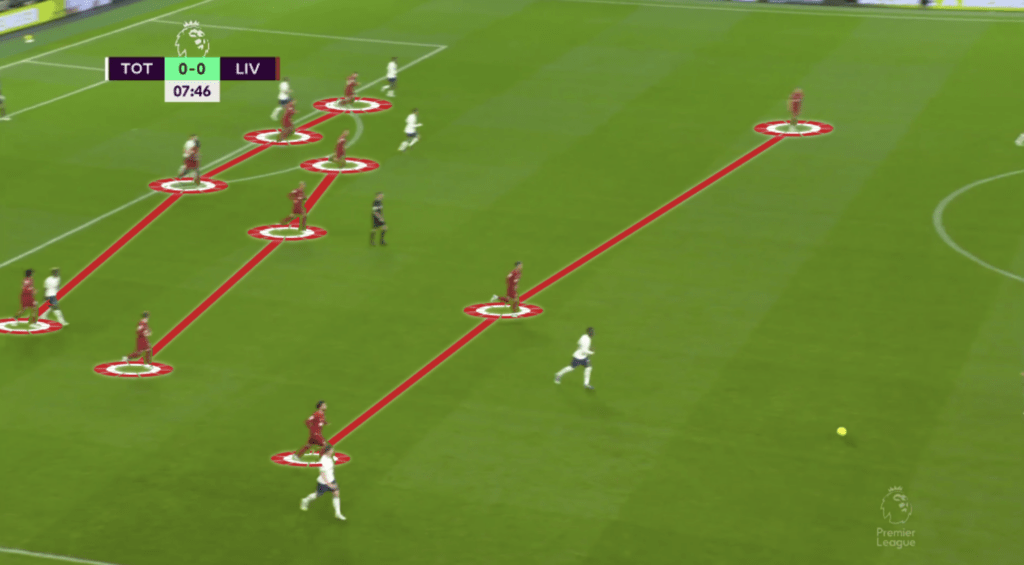
The Reds are dominating possession (61.8%), just as they did last season (63.2%) but pressed sequences per game are down from 20.2 to 15.5, high turnovers are down at 9.1 from 11.7 and their PPDA average is 11.9 when it was 9.9 last term.
This is all very much by design. The new approach forces the opposition further up the pitch when in possession and this leaves space in behind for Núñez to attack. In the recent game against Spurs, Trent Alexander-Arnold found the striker with two near-identical passes.
The first instance saw Núñez one-vs-one with Emerson Royal with acres of space to attack. His cross-cum-shot narrowly missed Hugo Lloris’ far post. The second time he was in against Eric Dier but his touch let him down.
These situations only come about as a result of the new off-the-ball approach. By tempering their aggression without the ball and almost inviting the opposition to step up, Liverpool are able to create better one-on-one moments. Klopp’s team are controlling the space, both defensively and offensively.
In an interview earlier this year, William Spearman, Lead Data Scientist at Liverpool, gave a little insight into his Pitch Control models.
“Basically, it’s just the regions of the pitch that one player or a team are in control of. So, if a team were to try to pass to that point, that team would be in control. It shows how you can close off space, how you can create space with runs. It’s the fundamental notion of how you control space and how space is valuable. We call it ‘off-ball scoring opportunity’, which is an extension of the idea of pitch control.”
We’re already seeing how Núñez is playing a part in helping Liverpool control spaces due to his chaotic nature. This is where we’re seeing his game evolve, too. He’s assisting shots as well as taking them.
In the loss to Leeds, the 23-year-old created four chances. In the win over Spurs, he created two. Across both of those games, he completed 78% of his attempted passes. That is a better success rate than both Firmino and Salah, all while creating six chances.
Let’s focus on the ones from Liverpool’s most recent Premier League game against Spurs.
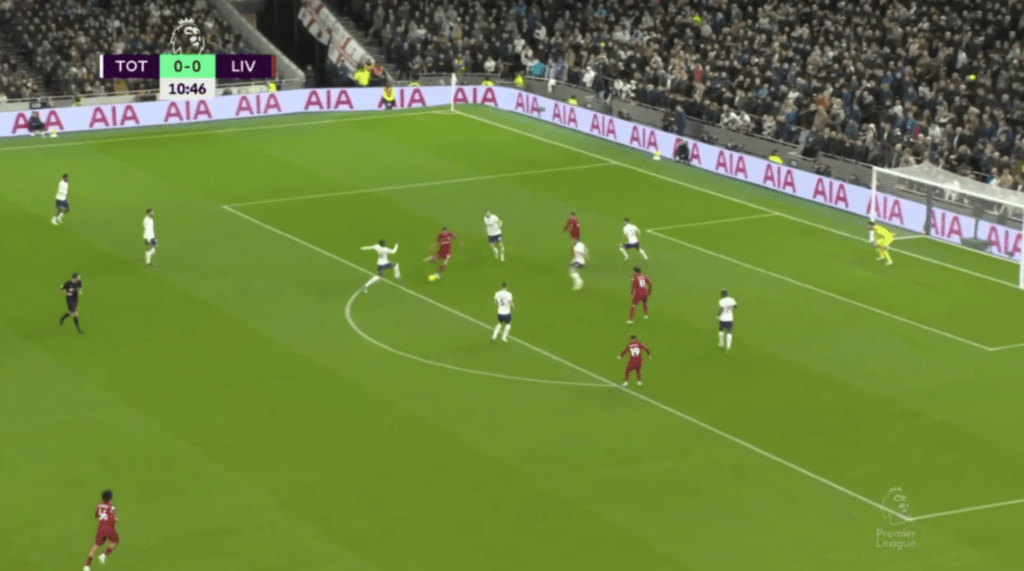
Above, as soon as Núñez spins on the ball to face the goal, the Spurs defenders react as though he is going to shoot. Clement Lenglet steps up and shapes his body for a block. He is solely focused on the one-time Almeria forward and seems oblivious to the fact Salah is fairly free in the penalty area.
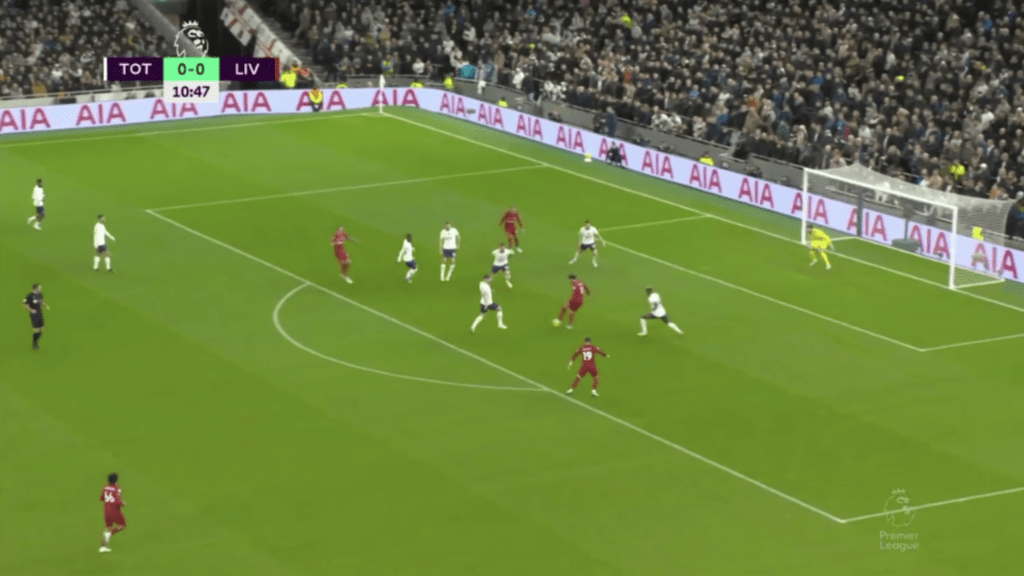
Three Tottenham players are drawn to Núñez and it creates the above situation. Salah, a three-time Golden Boot winner, has time to take a touch inside the penalty area before firing past Lloris.
This is a player who is frequently triple-teamed by the opposition as they look to shut him down. This time, though, he’s free in the box as everyone gravitates towards Núñez.
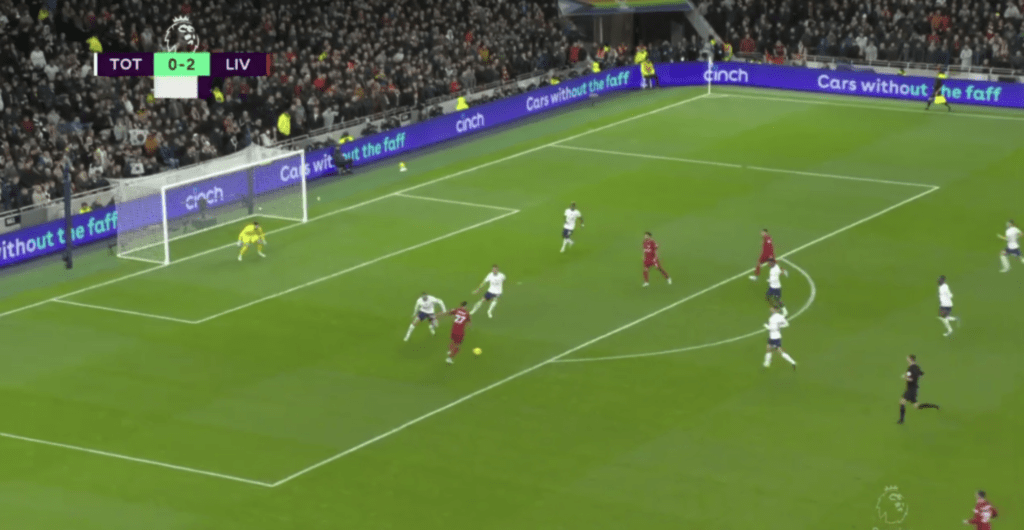
The same thing happened again early in the second half. Having picked up the ball in a wide area, Liverpool’s No. 27 cuts inside and occupies both Dier and Lenglet. The pair look to block off any potential shot and, again, allow Salah to waltz into the area.
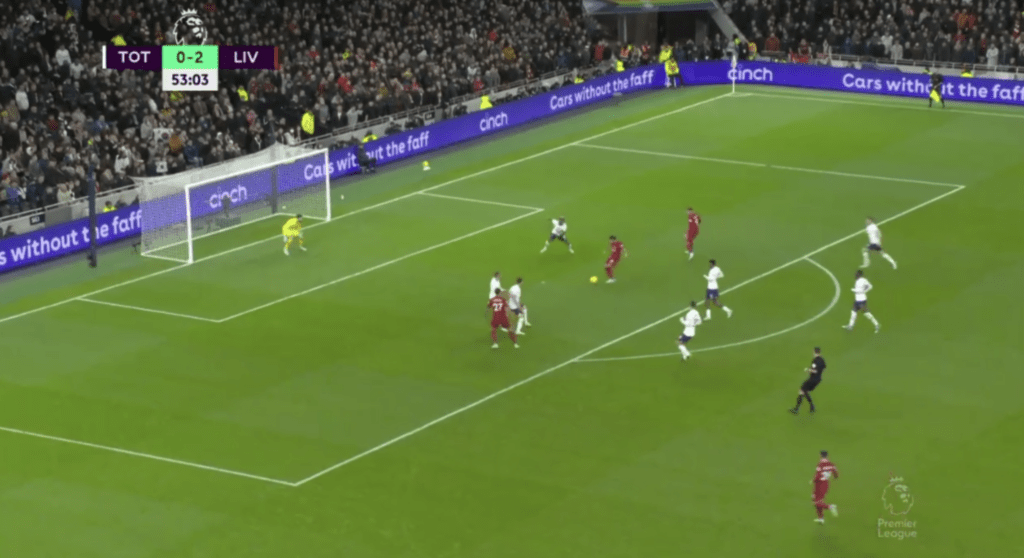
Núñez plays it to the eventual match-winner but his first-time effort is a tame one and easy for Lloris. He had time and space to take at least one touch.
The point is, the 23-year-old’s mere presence and reputation for shooting from that particular part of the box (as evidenced in his shot map below) is creating space for Salah inside the penalty area.
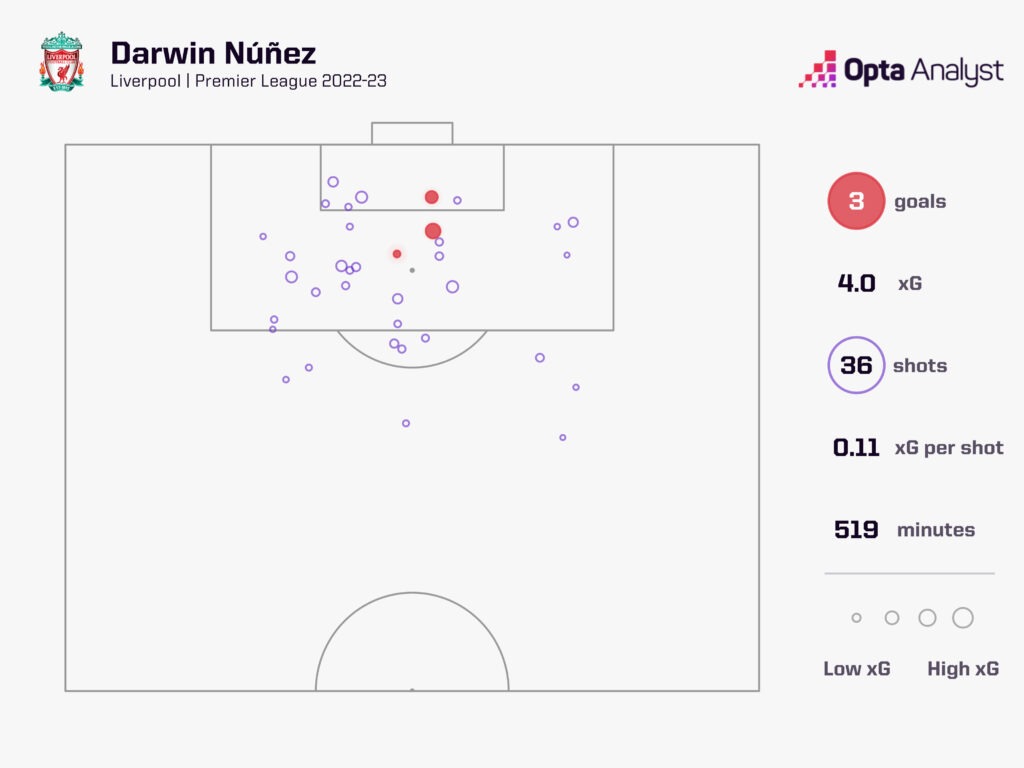
It has the potential to be one of the best pairings in the Premier League. In fact, right now it is. Of all pairs to play 400+ mins together in the English top-flight this season, Núñez and Salah create a chance for each other most often (one every 50 minutes). For comparison, Haaland and Kevin De Bruyne are averaging a chance for one another every 55 minutes and Heung Min-Son and Harry Kane are at 57 minutes.
There’s been a lot of talk over recent weeks about how you control the chaos that is Núñez. You don’t need to, you just embrace it.

